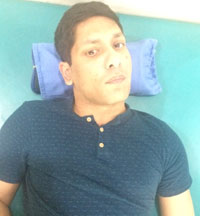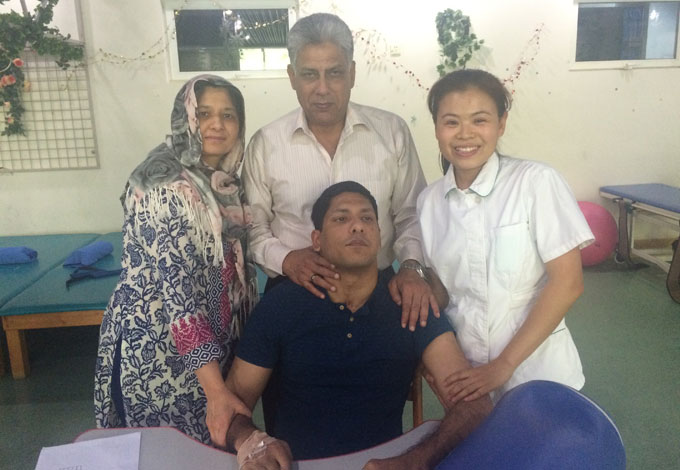 Name: Shumaz Shahid Name: Shumaz Shahid
Sex: Male
Nationality: Pakistani
Age: 29
Diagnosis: Sequela of brain injury
Date of Admission: May 2, 2016
Treatment hospital/period: Wu Medical Center/14 days
Before treatment:
Shumaz had a car accident on April 24th, 2014, he was in a coma, the CT showed he had a diffuse axonal injury, his right frontal bone and bilateral orbital floor fractured. The doctors cut into the trachea through the neck to rescue him. He received a nasal feeding tube and a subdural effusion’s suction. He woke up 7 months later, but he was unconscious, he was not able to move his arms or legs, he also had stiffness. His family members helped him do rehabilitation activities regularly. He had the nasogastric feeding tube removed 9 months later, and was put on a semi-liquid diet. He had epileptic seizures, and when they occurred, he would extend all four limbs, his head would shake and turn to one side, his lower jaw would shake. The doctor diagnosed him with epilepsy and prescribed Levetiracetam and Clonazepam to control the seizures 1 year ago. He came to our center and had stem cells treatment 6 months ago, after the treatment, his breathing was better, he had less nystagmus. Sometimes he had it when he slept. The muscle tension was lower than before; he was able to close his mouth. He took pills regularly after he was discharged. The muscle tension was lower, the epileptic seizures stopped. He responded to stimulus(he could bend his upper limbs in front of his chest).He was able to chew his food. He wanted a better life, so he came to our center again and he was diagnosed with sequela of brain injury.
He has been in good spirits since the onset of the disease. His diet is regular. He slept 12 hours each day. During his sleep, his eyeballs moved side to side sometimes. He was incontinent. He was able to defecate once in 2 days when his perianal region was stimulated.
Admission PE:
Bp: 106/70mmHg, Hr: 54/min, temperature: 36.0 degrees, Br: 20/min. The skin on the hips was ulcerated and scabbed, there were red rashes all over his back, and there was no yellow stain or petechia on his skin. His breathing was shallow and the respiratory sounds in both lungs were clear with no signs of dry or moist rales. The cardiac rate was normal, with no obvious murmur in the valves. The abdomen was flat and soft. The liver and spleen were normal. There was no swelling in the lower limbs. The skin temperature below his knees was cold.
Nervous System Examination:
Shumaz Shahid was alert but he was depressed. He was unconscious and had complete aphasia. His mouth was always opened. He was not able to cooperate with the memory, orientation, understanding or calculation abilities examinations. Both pupils were equal in size and round, the diameter was 3.0mms. Both pupils were sensitive to light stimulus. He was not able to stare at objects when he opened his eyes. The eyeballs moved less than before during sleep. There were occasional small amplitude movements. He didn’t cooperate with the other cranial nerves examinations or the muscle power examinations. The muscle tension was a little higher in all four limbs. Both feet were slightly bent downward. The bilateral biceps reflex, radial periosteal reflex, triceps reflex and right patella tendon reflex were active. The left side patella tendon reflex, both ankle reflexes and bilateral abdominal reflexes were non-existent. The doctor couldn’t examine the Hoffmann’s sign or Rossolimo’s sign because he was not able to open his hands. The palm jaw reflex and bilateral Babinski’s sign were positive. He was not able to do the other coordinated movement examinations. There was slight rigidity in the neck. The Kernig sign and Brudzinski’s sign were negative. Accessory examination: Head MRI (2016.2.16): 1. Bilateral frontal lobes, beside the grey matter and sagittal sinus were damaged. Based on the medical history, it was considered to be diffuse axonal injury 2. There was encephalomalacias on the right frontal lobe and right frontal region of the temporal lobes. 3. Communicating hydrocephalus.
Treatment:
Shumaz was diagnosed with sequela of brain injury. He received 3 neural stem cell injections and 3 mesenchymal stem cell injections to repair his damaged nerves, nourish the neurons, activate the new cells in his body, and improve his blood circulation. He also had physical rehabilitation training.
Post-treatment:
After 14 days of treatment, the degree of awareness was higher than normal. The muscle tension was lower than before; the left knee had a reflexive response.. Shumaz was able to cooperate with the orders.


| 
 Name:
Name: 


